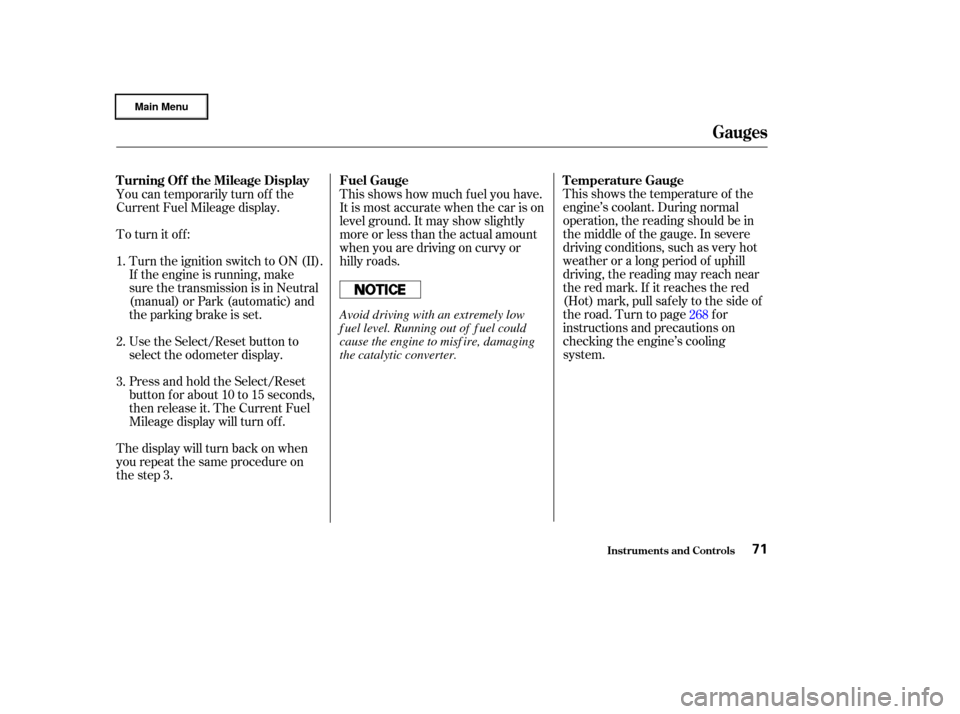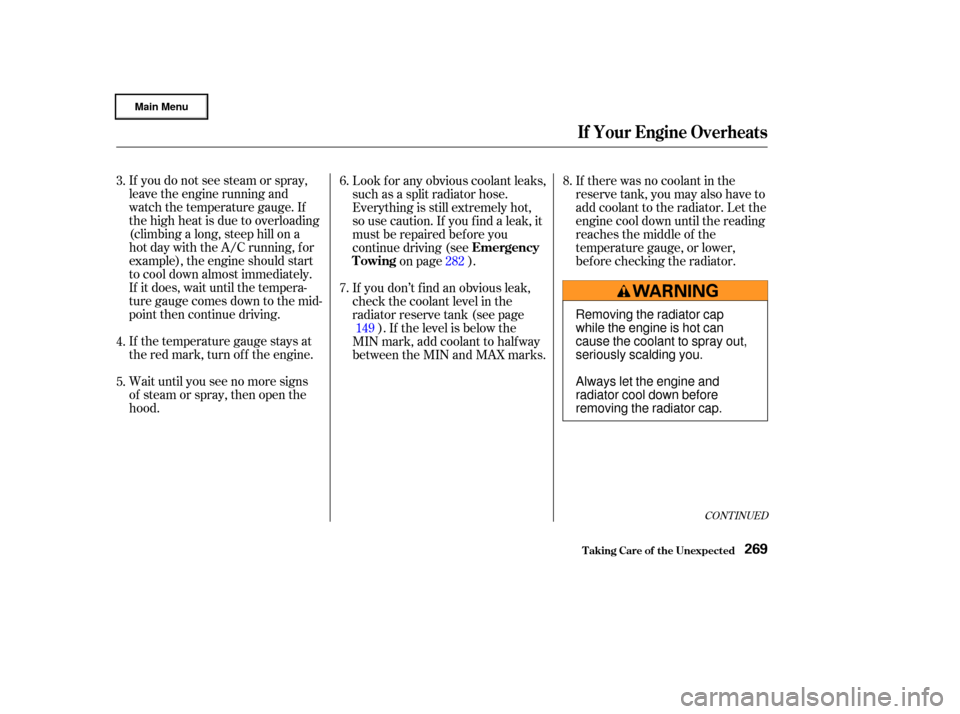Page 74 of 317

This shows the temperature of the
engine’s coolant. During normal
operation, the reading should be in
the middle of the gauge. In severe
driving conditions, such as very hot
weather or a long period of uphill
driving, the reading may reach near
the red mark. If it reaches the red
(Hot) mark, pull saf ely to the side of
the road. Turn to page for
instructions and precautions on
checking the engine’s cooling
system.
This shows how much f uel you have.
It is most accurate when the car is on
level ground. It may show slightly
more or less than the actual amount
whenyouaredrivingoncurvyor
hilly roads.
You can temporarily turn of f the
Current Fuel Mileage display.
To turn it off:
Turn the ignition switch to ON (II).
If the engine is running, make
sure the transmission is in Neutral
(manual) or Park (automatic) and
the parking brake is set.
Use the Select/Reset button to
select the odometer display.
Press and hold the Select/Reset
button f or about 10 to 15 seconds,
then release it. The Current Fuel
Mileage display will turn of f .
The display will turn back on when
you repeat the same procedure on
the step 3. 268
1.
2.
3.
Inst rument s and Cont rols
Temperature Gauge
Fuel Gauge
T urning Of f the Mileage Display
Gauges
71
Avoid driving with an extremely low
f uel level. Running out of f uel could
cause the engine to misf ire, damaging
the catalytic converter.
Page 115 of 317
Air conditioning also removes mois-
ture from the air as it operates. You
can use it to def og the windows
quickly in cool or damp weather.
Used in combination with the heater,
it also makes the interior warm and
dry.
Air conditioning places an extra load
on the engine. Watch the engine
coolant temperature gauge (see page) when using the A/C in heavy
traf f ic or driving up long hills. If the
reading reaches near the red mark,
turn of f the air conditioning until the
gauge reads normally. 71
Heating and Cooling (Automatic System)
Comf ort and Convenience Feat ures112
MODE CONTROL DIAL
TEMPERATURE
CONTROL DIAL
FAN CONTROL DIAL RECIRCULATION BUTTON AIR CONDITIONING BUTTONECON BUTTON
Page 166 of 317

The engine coolant is nearly up to
normal operating temperature.
The vehicle’s speed is below 19
mph (30 km/h) and you are
pressing on the brake pedal to
come to a stop.
You depress the clutch pedal.
You are not pressing on the
accelerator pedal.During Auto Idle Stop, the IMA
charge and power brake vacuum
reserve is monitored by the system.
If either drops below a desired level,
and the shif t lever is in Neutral, the
engine will restart so it can recharge
the IMA battery or replenish the
vacuum supply.
To maximize f uel economy, your
Civic Hybrid has an Auto Idle Stop
f unction. Under certain conditions,
the engine will shut of f when you
come to a stop. Those conditions are:
The IMA battery is charged
enough to operate the system.
The ECON mode is selected, and
the outside temperature is above
41°F (5°C), or the f an speed controldialisoff (seepage ).
There is adequate vacuum reserve
f or the power brakes.
When these conditions are met, the
engine will shut of f as you come to a
stop. It will start again automatically
when you depress the clutch pedal
and move the shif t lever to f irst gear.
There is no need to start the engine
with the ignition switch.
It is recommended that you move
the shift lever to Neutral and remove
your f oot f rom the clutch pedal while
you are stopped. Sitting with the
clutch pedal depressed and the shif t
lever in gear will cause the engine to
continue running, def eating the f uel
economy benef its of the Auto Idle
Stop f unction. The Auto Idle Stop f unction may not
activate when starting the engine or
if the IMA battery temperature is too
hot or too cold.
111
CONT INUED
5-speed Manual T ransmission
Driving
Auto Idle Stop
163
Page 174 of 317

The engine coolant is nearly up to
normal operating temperature.
The shift lever is in D or N.
You are not pressing on the
accelerator pedal.There is adequate vacuum reserve
f or the power brakes.
To maximize f uel economy, your
Civic Hybrid has an Auto Idle Stop
f unction. Under certain conditions,
the engine will shut of f when you
come to a stop. Those conditions are:
The IMA battery is charged
enough to operate the system.
The ECON mode is selected, and
the outside temperature is above
41°F (5°C), or the f an speed
controldialisoff (seepage ). When these conditions are met af ter
the vehicle speed has exceeded 10
mph (16 km/h), the engine will shut
of f as you are braking to a stop and
the vehicle speed goes below 5 mph
(8 km/h).
The engine will start again when you
release the brake pedal. It will also
restart, even if you are still pressing
the brake pedal, under these
conditions:
You are on an incline, and the
vehicle begins rolling. You press the accelerator pedal.
You move the shif t lever f rom D
or N to R or L. During Auto Idle Stop, the IMA
charge and power brake vacuum
reserve is monitored by the system.
If the vacuum reserve drops below
an optimal level, the engine will
restart to replenish the vacuum
supply. If the IMA charge drops
below an optimal level and the shif t
lever is in Neutral or Park (P), the
engine will restart to recharge the
IMA battery.
The Auto Idle Stop f unction may not
activate when starting the engine or
if the IMA battery temperature is too
hot or too cold.
111
Driving
Automatic Transmission (CVT)
Auto Idle Stop
171
Page 204 of 317
CONT INUED
Remove the radiator cap. Turn the ignition ON (II). Turn
the temperature control dial to
maximum heat. Turn of f the
ignition. Open the hood. Make
sure the engine and radiator are
cool to the touch.
Draining the coolant requires access
to the underside of the car. Unless
you have the tools and knowledge,
you should have this maintenance
done by a skilled mechanic. Thecoolingsystemshouldbe
completely drained and ref illed with
new coolant according to the time
and distance recommendations in
the maintenance schedule. Only use
Honda All Season Antif reeze/
Coolant Type 2.
Loosen the drain plug on the
bottom of the radiator. The
coolant will drain through the
splash guard. Drain the coolant
into an appropriate container.
1.
3.
2.
Replacing Engine Coolant
Cooling Syst em
Maint enance201
DRAIN PLUG
Page 271 of 317

The reading on your car’s
temperature gauge should stay in
the midrange under most conditions.
Itmaygohigherif youaredrivingup
a long steep hill on a very hot day. If
it climbs to the red mark, you should
determine the reason.Your car can overheat f or several
reasons, such as lack of coolant or a
mechanical problem. The only
indication may be the temperature
gauge climbing to or above the red
mark. Or you may see steam or
spray coming f rom under the hood.
In either case, you should take
immediate action. Saf ely pull to the side of the road.
Put the transmission in Neutral or
Park, and set the parking brake.
Turn of f the heating and cooling
system and all other accessories.
Turn on the hazard warning
indicators.
If you see steam and/or spray
coming f rom under the hood, turn
of f the engine.
1.
2.
T aking Care of t he Unexpect ed
If Your Engine Overheats
268
Steam and spray from an
overheated engine can
seriously scald you.
Do not open the hood if steam
is coming out.
Driving with the temperature gauge
reading at the red mark can cause
serious damage to your engine.
Page 272 of 317

CONT INUED
If you do not see steam or spray,
leave the engine running and
watch the temperature gauge. If
the high heat is due to overloading
(climbing a long, steep hill on a
hot day with the A/C running, f or
example), the engine should start
to cool down almost immediately.
If it does, wait until the tempera-
ture gauge comes down to the mid-
point then continue driving.
If the temperature gauge stays at
the red mark, turn of f the engine.
Wait until you see no more signs
of steam or spray, then open the
hood.Look f or any obvious coolant leaks,
such as a split radiator hose.
Everything is still extremely hot,
so use caution. If you f ind a leak, it
must be repaired bef ore you
continue driving (see
on page ).
If you don’t f ind an obvious leak,
check the coolant level in the
radiator reserve tank (see page ). If the level is below the
MIN mark, add coolant to halfway
between the MIN and MAX marks. If there was no coolant in the
reserve tank, you may also have to
add coolant to the radiator. Let the
engine cool down until the reading
reaches the middle of the
temperature gauge, or lower,
bef ore checking the radiator.
3.
4.
5. 6.
7.
8.
282
149
T aking Care of t he Unexpect ed
If Your Engine Overheats
Emergency
Towing
269
Removing the radiator cap
while the engine is hot can
cause the coolant to spray out,
seriously scalding you.
Always let the engine and
radiator cool down before
removing the radiator cap.
Page 273 of 317

Using gloves or a large heavy
cloth, turn the radiator cap
counterclockwise, without pushing
down, to the f irst stop. This
releases any remaining pressure in
the cooling system. After the
pressure releases, push down on
the cap and turn it until it comes
off.
Start the engine and set the
temperature control dial to
maximum. Add coolant to the
radiator up to the base of the f iller
neck. If you do not have the
proper coolant mixture available,
you can add plain water.
Remember to have the cooling
system drained and ref illed with
the proper mixture as soon as you
can.Put the radiator cap back on
tightly. Run the engine and watch
the temperature gauge. If it goes
back to the red mark, the engine
needs repair. (See
on page .)
If the temperature stays normal,
check the coolant level in the
radiator reserve tank. If it has
gone down, add coolant to the
MAX mark. Put the cap back on
tightly.
9.
10. 11.
12.
282
T aking Care of t he Unexpect ed
If Your Engine Overheats
Emergency
Towing
270